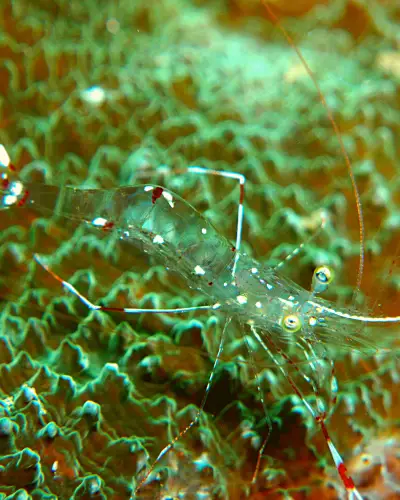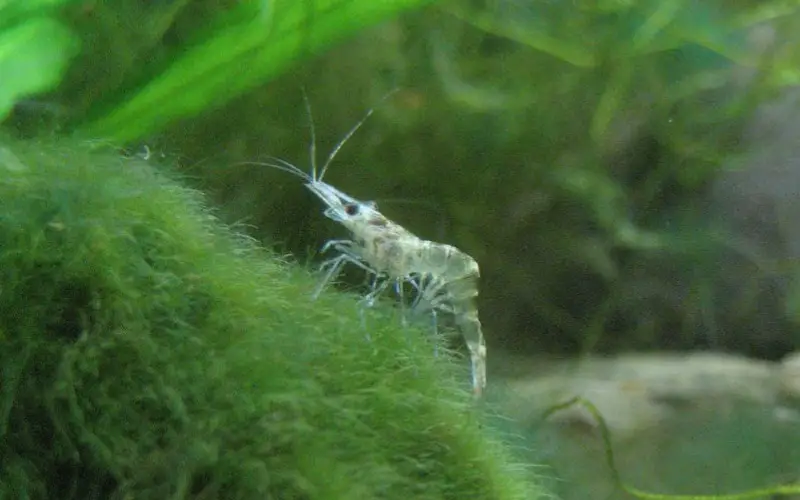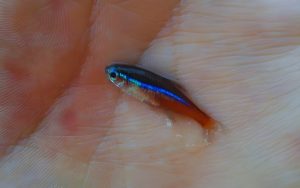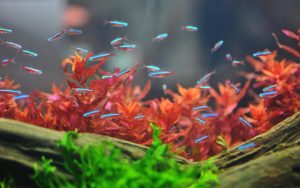If you’re a proud pet parent of a pregnant ghost shrimp, you might wonder what your ghost shrimp Pregnancy process looks like.
From signs and pregnant ghost shrimp stages to care needs during the gestation period, there’s much to consider when navigating through the beautiful but sometimes confusing world of shrimp pregnancy!
Are you looking for accurate, up-to-date information on how to care for your pregnant ghost shrimp?
With the need for more reliable resources, figuring out the perfect way to take care of your beloved ghost shrimp can be incredibly frustrating. It doesn’t have to be so difficult.
Our ultimate guide covers all the essential steps if your ghost shrimp is pregnant, from signs and cares during each stage of pregnancy to hatching and beyond.

With this resource at your fingertips, managing your pregnant ghost shrimp will no longer be a nightmare.
In this blog post, we’ll uncover all spawning stages for baby ghost shrimps and provide essential insights into proper care for parenting shrimps before, during, and even after their exciting journey toward reproduction.
Read on for more details about one famous (and somewhat mysterious!) aquarium creature!
Table of Contents
ToggleCan Ghost Shrimp Get Pregnant?
While the term “pregnant” is not typically used to describe the reproductive process in shrimp, female ghost shrimp carry eggs and undergo a process called “berried.“
Female shrimps produce eggs, which they carry under their abdomen. The male ghost shrimp fertilize these eggs during mating.

As the eggs develop, they become visible through the female’s translucent exoskeleton, giving the appearance of a cluster of berries, hence the term “berried.”
So, while ghost shrimp don’t get “pregnant” like mammals do, they carry eggs and go through a reproductive process that culminates in the hatching of their offspring.
Pregnancy Phases for Female Ghost Shrimp
The pregnancy can be as soon as three weeks or nine weeks in adult sex. Egg laying and fertilization take approximately six to eight weeks.
Female shrimp undergo three main stages of pregnancy. These stages include the pre-mating phase, mating phase, and post-mating phase.
What Are the Stages of Ghost Shrimp Pregnancy?
If you’re a freshwater aquarist with Ghost Shrimp, you may have noticed that your female shrimp has enlarged and darkened in color. But what does this mean?
Knowing how to detect the pregnancy stages of your Ghost Shrimp is essential for properly caring for them – but it can be harsh to differentiate between the various phases as they progress.
Here are the three phases of Shrimp Ghost Pregnancy:
- During the pre-mating phase, female Ghost Shrimp will develop specialized reproductive organs known as gonopodia on their undersides that act as egg carriers. During this pregnant ghost shrimp stage, they also produce whorl-like bands on their bodies to attract male ghost shrimps for mating.
- The mating phase lasts two days, and during this time, female Shrimp mate with multiple males to ensure good genetics for their offspring. During this time, the male shrimp transfer sperm to the female, stored in her stomach pouch for later use when laying eggs.
- In the post-mating phase, a bonded pair of male and female shrimp will lay between one hundred fifty to one thousand eggs over several weeks, depending on the water temperature and available food supply.
The tiny yellow or orange-colored eggs are attached beneath either side of the female’s body near her tail fin before they drop off into an incubation site, such as crevices in rocks or other objects located underwater that provide shelter from predators and currents until hatching occurs ten days later.
Once hatched, mother Ghost Shrimp take care of their young by fanning them with gills to aerate the water for breathing purposes while protecting them from potential dangers until after a few days when juveniles can fend for themselves independently in open waters if necessary conditions permit survival success.
Can Ghost Shrimps Breed In Community Tanks?
Yes, ghost shrimp breed in community tanks; however, the success rates are relatively low. Fish are hungry to eat ghost shrimp larvae while they are growing older, so they will naturally reduce the number of eggs that hatch.
It’s best to provide plenty of hiding spaces and food sources. To maximize egg hatching and ensure a healthy population of Ghost Shrimp in your tank,
Ghost Shrimp also needs a variety of temperatures to reproduce successfully, so if possible, provide a temperature gradient so the female can find an optimal temperature for her eggs.
Lastly, it’s also essential to ensure the community tank is clean and free from any parasites or other diseases that can potentially harm the Ghost Shrimp eggs.
These simple tips can increase the chances of successful breeding and ensure a healthy population in your ghost shrimp breeding tank.
Signs of Pregnant Ghost Shrimp
How to Tell if a Female Ghost Shrimp Is Pregnant: The following three indicators of pregnancy with Ghost Shrimps can be seen.
– White or Light Green Dots under the Tail
That’s probably most clearly an indication your shrimp are pregnant. A white line under the wingtips of Ghost Shrimps indicates they are successful mates. During pregnancy, your ghost shrimp will have similar white dots and grow larger.
Ghost shrimp eggs have clear outer covers and are easily identifiable through their translucent outer coating. This is one reason pregnant Ghost Shrimp is so fascinating.
– Consistent Leg Fanning or Splaying
Experienced aquarists observed increasing numbers of pregnant Shrimp fans and splayed their arms. It is believed that these activities help aerate eggs and maintain optimum temperatures. Other fish keepers say that being gravid ghost shrimp may irritate female ghost shrimp.
– Weight Gain
Usually, the male that cohabitates with the female’s breeding tank competes for their attention, and they have hoped to become the first ones whose eggs would be fertilized. Add 20-25 eggs to make your female ghost shrimp appear bigger than previously observed.
Male attention, In other words, your female ghost shrimps are suddenly getting more attention than they had before. Typically ghost shrimp are not born until three months of age and have a small number of female offspring if they are healthy.
How Often Do Ghost Shrimp Have Babies?
How often can I breed my ghost shrimp? Ghost shrimp reproduce pretty quickly, with adults being able to produce babies every few weeks at least. The gestation period of the ghost shrimp is only about two weeks long.
This means it doesn’t take too long for the babies to appear after mating. The female shrimp carries her eggs in a pouch on her underside until they are ready to hatch.
Each litter generally contains between 30 and 50 baby shrimps, although some scraps can have as many as 100 or more!
It is also not uncommon for ghost shrimp populations to experience multiple generations within a single season, especially in areas where temperatures remain warm year-round.
Furthermore, when ghost shrimp reach maturity, they don’t need an external source of oxygen to mate and have offspring like other aquatic animals do – this makes their reproduction process much easier and faster than most other species.
How Long Is a Ghost Shrimp Pregnant For?
How long do ghost shrimp stay pregnant? Ghost shrimp can breed at least three times a year. It took around four to five weeks for a female’s egg to hatch and the male’s egg to reproduce (1 to 3 weeks).
Ghost shrimp are bred from 3 to 9 weeks old. In the table below, ghost shrimps give their eggs when they become pregnant. This helps plan your shrimp and provides plenty of room to keep them healthy.
How Many Babies Do Ghost Shrimp Have?
How Many Fry Do Shrimps Ghost Give Birth To? Ghost shrimp lay between 30 and 50 eggs a week. Some larvae reach adulthood. Mortality for Ghost Shrimps is high. You have to ensure the whole thing works so they do not die.
If you intend on breeding Ghost Shrimp, you should understand the number of babies. Typically Ghost Shrimp has about 80 babies at once. It will surely add up in a year, and they may end up with 100 babies.
It’s important to note that ghost shrimp babies are tiny and require specialized care. Ghost shrimp fry thrives in tanks with large plants, hiding spots, and stable water parameters.
The fry will not tolerate high levels of ammonia or nitrite, so ensuring your community tank is well cycled before attempting to breed ghost shrimp is essential.
Caring For Pregnant Ghost Shrimps
If you begin finding pregnant ghost shrimp, immediately move them into breeding pools for a breeding program.
But it would help if you were gentle to avoid harming your mother’s shrimp and eggs. Use a cable and quickly transfer them into a prepared fry tank. If necessary, keep tanks nearby to move women. They have a reputation for dropping eggs under stress.
Once fertilized, the incubating period varies from 24 to 24 days. During these times, feeding gravid shrimps with nutritious meals is essential. Take them to eat vegetation or insect foods if possible. Nonetheless, ensure not to overeat.
Feed your pregnant ghost shrimp a variety of food. Vegetable and protein-rich foods, such as blanched spinach and cooked peas, will help provide all the necessary nutrients for their eggs and fry.
Remember that ghost shrimp are sensitive to water quality, and you should only feed your pregnant shrimp with high-quality food.
How To Setup Ghost Shrimp Breeding Tank?
Having a separate breeding tank for ghost shrimp is vital since newly conceived young are difficult to keep alive, especially in crowded adults and fish. This is how we set up a breeding tank to help the juvenile ghost shrimps survive.
First, you’ll need a tank with at least 10 gallons of volume. Next, add some hiding places like rocks and caves for the adults. Then fill the tank with dechlorinated water with a ph level of 6.5-7.5, slightly soft to medium hardness, and a temperature of 64-84F.
Finally, add some live plants and aeration to ensure the water is safe for the baby ghost shrimp. This will give the adults plenty of space to hide while providing a safe environment for the fry to grow and thrive.
With all these conditions, your breeding tank should have the perfect environment for our ghost shrimp. Now you can start breeding and raising healthy baby ghost shrimps!
Install Filters And Air Pumps
Shrimp molts need fresh drinking water. Hoses must be kept completely clean throughout the breeding tank and the tank’s life. You can put whatever filter into your community tank that will work most efficiently.
For instance, I use canister filters as tanks have guppies tetras. Most filters use water to wash them. This problem should be resolved in our fry tank.
So use sponge filters to filter out the water. This Hikari USA sponge filter offers excellent value for very reasonable prices. In addition, the pump should contain air so the air can be supplied to everyone. This will provide oxygen so that our shrimp fry can breathe better.
Remember to clean the filter weekly to ensure it runs smoothly and efficiently.
How Do You Know if Your Ghost Shrimp Is About to Give Birth?
Pregnant ghost shrimp giving birth has a few telltale signs you can look out for. Firstly, you may notice the female’s abdomen swelling up.
Additionally, she will be active and have an increased appetite. You may also see her pushing against the tank walls and other objects to release her eggs.
When it’s time for the birth, you can expect to see a small pouch attached to her body filled with eggs. This is typically released within 24 hours of labor and is a sign that the eggs have hatched.
Finally, you may notice that the pregnant female ghost shrimp stops eating after giving birth as she focuses her energy on looking after her babies.
As the fry grows, you can expect to see more and more shrimp fry in the bottom of the tank. If you provide enough food, plenty of hiding places, and other necessities, your ghost shrimp population will surely grow!
How to Tell If Ghost Shrimp Eggs Are Fertilized?
Fertilized ghost shrimp eggs appear slightly opaque, while unfertilized eggs are transparent. A black spot in the center of the egg can also identify the fertilized eggs.
In addition, ghost shrimp eggs are slightly red or orange when fertilized. If you notice these signs, your ghost shrimp eggs are most likely fertilized and will soon hatch!
Once the eggs have hatched, you should provide plenty of food and hiding spots for the baby ghost shrimp. You can add a few live plants to help keep the water clean and give the fry somewhere to hide. With a bit of care, your ghost shrimp population will indeed thrive!
Caring for and Feeding Ghost Shrimp Fry
The birth of another generation of Ghost Shrimps has given us a perfect idea of how to handle these tiny creatures. The main challenge in breeding Ghost Shrimp isn’t getting them to partner but helping the newborn Shrimp survive his first week in the aquarium.
Give your little ghost shrimp some tips on how to keep them healthy for adult life:
- 1. Feed them high-protein foods that are small enough for their mouths and stomachs, such as baby brine shrimp, bloodworms, and other small crustaceans.
- 2. Protect them with various hiding spots like rocks or plants.
- 3. Keep the water clean and perform regular partial water changes.
- 4. Consider adding an air stone or other aerator to ensure the water is well-oxygenated.
- 5. Monitor their growth and health to ensure they adapt to their new environment.
With the proper care, your Ghost Shrimp fry will grow into healthy adults and add variety to your aquarium. With effort and patience, you can ensure your Ghost Shrimp fry thrives!
What Do Baby Ghost Shrimp Eat?
Baby Ghost Shrimp are omnivorous, meaning they can eat various foods. These tiny crustaceans feed on microbial films, small organic matter such as soft vegetables, and other zooplankton and invertebrates in their natural habitats.
They may also nibble on algae growing in the substrate. When kept in captivity, baby Ghost Shrimp generally enjoy commercially available fish food pellets or flakes formulated for bottom-feeding species and frozen foods such as brine shrimp, blood worms, and mysis shrimp. You can even try liquid fry food or sinking wafers.
It’s also essential to supplement their diets with flake foods occasionally to give them the vital minerals and vitamins babies need for healthy growth.
Ghost Shrimp Eggs for Sale
Ghost Shrimp eggs are available for sale in pet stores, specialty aquarium stores, and online. Before you buy them, make sure to choose eggs from a reputable supplier.
You should also check the eggs carefully for signs of infestation or disease, which can be challenging to spot in small eggs. When you purchase Ghost Shrimp eggs, storing them properly in a cool, dark place and keeping them moist is essential.
Commonly Asked Questions about Pregnant Ghost Shrimp (FAQ)
Do Ghost Shrimps Lay Eggs or Give Birth?
Ghost shrimp lay eggs. These are eggs that cannot be carried into the body. Then it nourishes the egg by the yolk and by placental attachment. Usually, eggs can be fertilized by a male. Consequently, pregnant female ghost shrimp carrying eggs can be considered gravid, not pregnant.
Do Ghost Shrimp Give Live Birth?
No, ghost shrimp do not give live birth. They lay eggs in a brood pouch, and the baby shrimp hatch from the eggs once fertilized. Once the eggs are laid, they don’t require any additional care or attention from the mother, and she will not give birth to live young ghost shrimp.
How Long Does it Take for Shrimp Ghost Eggs to Hatch?
On average, it is expected about 2-3 weeks for the eggs of a ghost shrimp to hatch. It can sometimes take longer if the water temperature could be better, and other environmental factors affect the hatching process, such as too much ammonia or nitrates in the water. In short, After fertilization, a 12 to 14-day incubation period ensues. Following this, tiny and fragile larvae emerge and begin free swimming.
Will Ghost Shrimp Eat Baby Fish?
Yes, Ghost Shrimp will eat baby fish if they can catch them. While the babies are small and very fast, the adult Ghost Shrimp can sometimes out-maneuver them and snatch them up before they can escape.
Do Ghost Shrimp Lay Their Eggs in the Aquarium?
Yes, Ghost Shrimp will lay their eggs in the aquarium if there are enough food and suitable conditions for them to do so. However, the eggs are not viable in saltwater and will not hatch, so providing them with freshwater conditions is crucial if you want them to hatch successfully.
How To Know When Ghost Shrimp Eggs Will Hatch?
Ghost Shrimp Eggs Hatching signs: There are several ways to tell when Ghost Shrimp eggs will hatch. The first is to look for small white dots on the eggs, which indicates when the embryos have started to develop.
Why Are My Ghost Shrimp Eggs Black?
Ghost shrimp eggs typically start milky white and then turn black as they mature. The Pregnant Ghost Shrimp Black Eggs indicate that the eggs are nearing hatching, and if you see them closely, you may be lucky enough to watch them emerge!
How Can Ghost Shrimp Die from Breeding?
Ghost Shrimp can die from breeding if they are not provided with the right environment. They require clean and well-oxygenated water and the right food and temperature to breed successfully. If these requirements are unmet, the shrimp can become stressed, weak, and eventually die.
What Is Common Ghost Shrimp Mating Behavior?
Males and female ghost shrimps have different behavior when breeding, but they recognize their respective behavior patterns, and a baby shrimp is the final product of their pairing.
Will a Ghost Shrimp Die After Laying Eggs?
If a ghost shrimp were adequately treated and fed and water conditions were optimal, the sperm would not die when it lays its eggs. After the egg has been laid, the embryos can continue to lay eggs similarly; once the embryo dies, the baby can be cycled throughout the life cycle.
Do Ghost Shrimps Eat Their Babies?
Ghost shrimp can eat your baby! Why this happens hasn’t been explained yet, but it’s probably because of two different things:
Conclusion
Helping your ghost shrimp through their pregnancy with proper care and attention can be a rewarding and beautiful experience. All you need is the appropriate practice and experience to ensure they’re successful. After learning all the signs, stages, and tips you need to give them a better chance of having healthy young ones, you should feel confident in setting up appropriate arrangements for helping with their maternity needs. You can watch these unique creatures thrive by planting food sources like bloodworms and providing plenty of moss and rocks, which they can hide while building nests. Remember: even small acts of kindness can do wonders for our undersea friends! Now go forth and help your ghost shrimp get a happy ending!
You might also like
- What Does a Ghost Shrimp Eat: Top 5 Foods For Optimal Health
- Does Ghost Shrimp Eat Algae: Let’s Clear Up All the Confusion!
- Ghost Shrimps Care 101: Some Excellent Facts You Can’t-Miss!
- Ghost Shrimp life span 101: Excellent Tips You Can’t-Miss
- Female Pregnant Ghost Shrimp Stages: Comprehensive Breeding Guide
- Ghost Shrimp Care 101: Ultimate Guide & Breeding Tips
- How Long Do Ghost Shrimp Live for: (Prolong Their Lifespan)
- Breeding for Ghost Shrimp: Unlock the Secrets of Successful Raising
- Ghost Shrimp Eggs: 5 Simple Tips for (Successful Hatching)
- How Many Ghost Shrimp Per Gallon: (A Comprehensive Guide)





